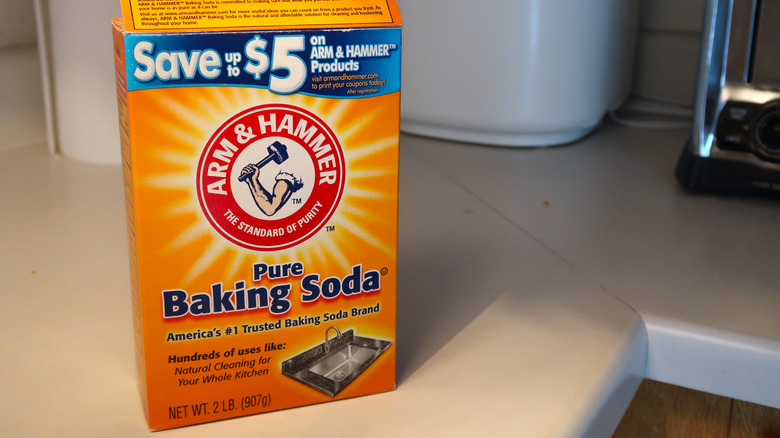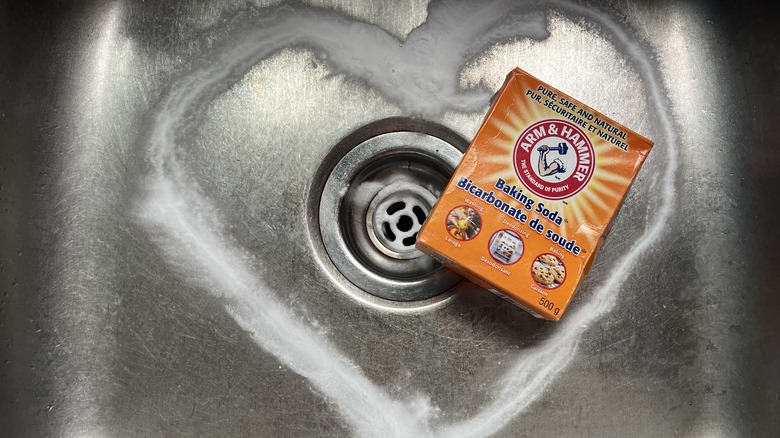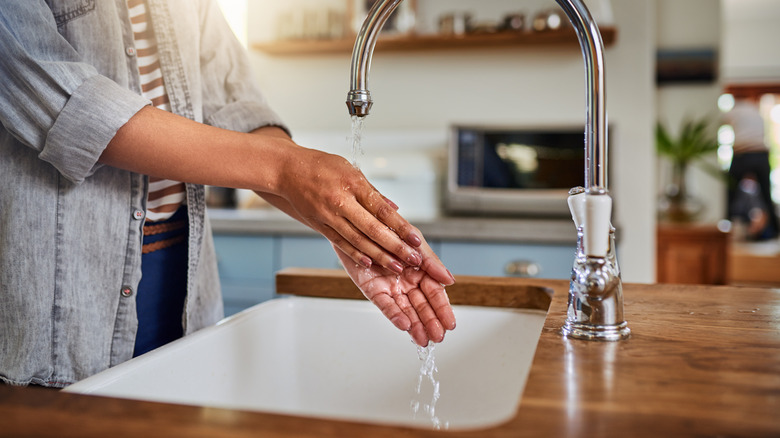Why You Should Keep A Box Of Baking Soda Near Your Sink
Baking soda, or sodium bicarbonate, is a common staple in the American kitchen, but did you know it serves other purposes? The powder is an alkaline (base) ingredient, meaning it has a pH value above 7 and is the opposite of acidic. This alkalinity produces carbon dioxide when it mixes with acids like vinegar or lemon juice. Carbon dioxide makes baked goods rise, and it's also the reason this white powder is a fantastic cleaning agent. The releasing gas fizzes and disturbs stuck on dirt. In fact, there are many baking soda cleaning hacks that are worth trying.
From degreasing the kitchen drain to cleaning your hands, it's useful to keep a box of baking soda sink-side. This ingredient is also easy to find and affordable, making it a great alternative to chemical cleaners. You can pick up a box in most grocery stores or grab a larger 15-pound bag for around $29 at your local Walmart. Wondering what to do with all that baking soda? Check out these ways to keep hands and dishes grease-free and smelling fresh.
Clearing drains and cutting through grease
The kitchen sink sees its share of dirty dishes. Even with a pre-rinse, food particles and stuck-on grease wind up in the drain. Baking soda is a gentle and natural way to clean your pipes and can keep your septic system running freely with regular use. To clear the sink, add ½ cup of baking soda, followed by ½ cup of white vinegar, and plug the drain with a cloth or rag. Wait 30 minutes and boil a kettle of water. Pour the boiling water down and repeat if the clog doesn't move. It's rewarding to find common pantry ingredients that can bust through clogged drains, but that's not all it can do. You can also use this cooking staple to degrease dishes.
Many foods release oil naturally while cooking. Some people also add oil to keep food from sticking or to increase flavor. Unfortunately, cooked-on grease is tough to get off. This is where your magic powder comes in. After soaking greasy pots and pans in hot water, remove the rest of the residue by sprinkling them with a few tablespoons of baking soda, followed by a squeeze of lemon juice. After 10 minutes, wipe the grease off. Like the powder and vinegar in the drain, acidic lemon juice causes the mixture to fizz, ridding your dishes of unwanted oil. Keeping baking soda on the side of your sink also makes it easy to clean oily fingers and deodorize skin.
Baking soda as a hand cleanser and odor eliminator
The kitchen sees plenty of hand washing, from a post-garden scrub to a pre-dinner wash-up. Baking soda isn't an everyday soap alternative, as it's a mild abrasive. However, it's useful in several kitchen-specific wash-up instances, including removing food coloring stains and odors from your hands. The stain removal magic of this powder occurs because sodium bicarbonate breaks down organic compounds, and the gentle abrasion scrubs off hard-to-remove particles. In the case of removing bad smells from your hands, the deodorizing properties are due to alkalinity levels. Many bad smells are acidic in nature and the sodium bicarbonate neutralizes the scents, rendering them less smelly. So, how much should you use for these hygiene tasks?
For stained fingers following the use of food dye or pigment-rich spices, make a paste with baking soda and water and apply it to the colored areas. To remove the lingering musk of garlic, onion, or other strong-smelling ingredients, add 2 teaspoons of baking soda to your hands and scrub. In both of these applications, you can rinse well and repeat as necessary. Knowing blocked drains, greasy dishes, and stained or stinky hands can all be fixed with a little sprinkle of this pantry staple, it only makes sense to keep it nearby. After all, you never know what the next unexpected way to use baking soda in your home will be. Fill a small dish and keep it next to the sink for easy access.


